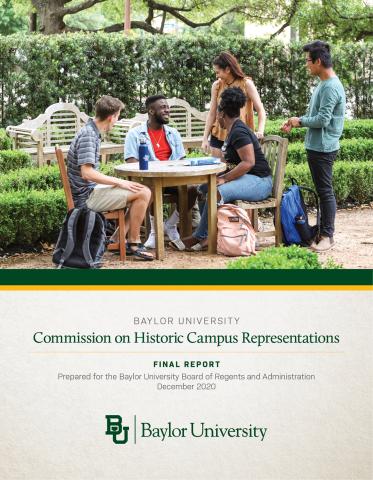Executive Summary
On June 26, 2020, the Baylor University Board of Regents announced its unanimous approval of the “Resolution on Racial Healing and Justice,” acknowledging Baylor’s historical connections to slavery and the Confederacy and establishing the Commission on Historic Campus Representations. Working in a thorough, prayerful and efficient manner, the 26 members of the Commission faithfully fulfilled their charge to review the historical record and context of the University and its early leaders and to evaluate and offer guidance regarding all statues, monuments, buildings and other aspects of the campus within this context. The Commission delivered its final report to the Board Chair and University President in December 2020.
The members of the Commission represented the diversity of the Baylor Family, including individuals from a variety of backgrounds and experiences and from the ranks of Baylor’s student body, faculty, staff, alumni and regents.
Several key historical facts that previously have not been acknowledged set the stage for the Commission’s recommendations:
-
Baylor’s founders and early leaders, including trustees and presidents, were slaveholders. Several continued to justify and support slavery even after the Civil War. The records of the enslaved and their descendants are difficult to find. The Commission references these as the “unknown enslaved.”
-
Judge R.E.B. Baylor, the University’s namesake, was a slaveholder. Enslaved persons formed a significant portion of his wealth in 1860. He did not serve in the Confederate army, but he did continue serving as a judge in Texas during the Civil War.
-
In 1843, founders William Tryon and James Huckins were slaveowners while serving as employees of the American Baptist Home Mission Society. After tensions between Baptists in the north and south over slavery reached an impasse, the Southern Baptist Convention was established in 1845, and Tryon and Huckins were appointed by the Domestic Mission Board of the Southern Baptist Convention in 1846. Huckins left Texas in 1859 and was appointed a chaplain in the Confederate army in 1863.
-
Rufus Burleson was a slaveholder and enlisted in the Confederate army, serving as a chaplain. As president of Baylor and subsequently Waco University, he encouraged faculty and male students over 18 to join the fight against what he called “Abolition despotism.” He was a prominent supporter of the “Lost Cause” movement following the war.
Among the recommendations found in the Commission’s report concerning historic representations — many of which provide multiple options for resolving the connection to slavery and the lack of well-rounded historical context — are the following:
-
While acknowledging the intent of the installation of monuments in Founders Mall, including the statue of Judge Baylor, was in celebration of the vision of the founders and first trustees to establish a Christian institution, the full history about these individuals is absent and should be told. No recommendation was made to remove the statue of Judge Baylor.
-
Others who contributed to the successful founding of the University, including the unknown enslaved, are not memorialized in any way, and it is recommended by the Commission that this be rectified with a new installation.
-
Burleson Quadrangle, a prominent gathering place for the Baylor Family, should be renamed and a more inclusive name be given to the space. The monument to Rufus Burleson should be relocated to a less prominent location on campus.
-
The University should create an intentional honoring of people of color who have contributed to Baylor’s history with statues or other installations on campus.
-
Markers and displays at the historic sites at Independence (the initial Baylor campus) should be updated to incorporate the full history of the University. In addition, Baylor’s Line Camp experience should incorporate more complete information about Baylor’s founders and early leaders when students are visiting the Independence site.
-
The University Mace should be retired and, if needed, a new mace fashioned in a way that reflects the rich diversity of Baylor.
The full, independent Report of the Commission, including the historical context and recommendations for each historical representation studied by the group, is available on this site. The Report reflects the unanimous conclusion of the Commission members.
